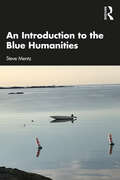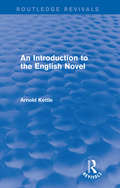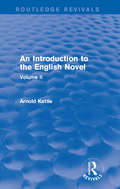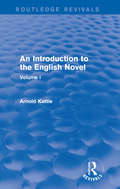- Table View
- List View
An Introduction to Sociolinguistics
by Janet Holmes Nick WilsonIn this best-selling introductory textbook, Janet Holmes and Nick Wilson examine the role of language in a variety of social contexts, considering both how language works and how it can be used to signal and interpret various aspects of social identity. Divided into three sections, this book explains basic sociolinguistic concepts in the light of classic approaches as well as introducing more recent research. This fifth edition has been revised and updated throughout using key concepts and examples to guide the reader through this fascinating area, including: a new chapter on identity that reflects the latest research; a brand new companion website which is fully cross-referenced within this book, and which includes and video and audio materials, interactive activities and links to useful websites; updated and revised examples and exercises which include new material from Tanzania, Wales, Paraguay and Timor-Leste; fully updated further reading and references sections. An Introduction to Sociolinguistics is the essential introductory text for all students of sociolinguistics and a splendid point of reference for students of English language studies, linguistics and applied linguistics.
An Introduction to Sociolinguistics (Learning about Language)
by Janet Holmes Nick WilsonSociolinguistics is the study of the interaction between language and society. In this classic introductory work, Janet Holmes and Nick Wilson examine the role of language in a variety of social contexts, considering both how language works and how it can be used to signal and interpret various aspects of social identity. Divided into three parts, this book explains basic sociolinguistic concepts in the light of classic approaches, as well as introducing more recent research. This sixth edition has been revised and updated throughout, using key concepts and examples to guide the reader through this fascinating area, including: • New material on gender, social media and online use of language, code-switching, and language policy • An updated companion website that is fully cross-referenced within this book and featuring video and audio materials and links to useful websites. • Revised examples and exercises that will include new material from Asia and South America • Fully updated further reading and references sections. An Introduction to Sociolinguistics is an essential introductory text for all students of sociolinguistics and a splendid point of reference for students of English language studies, linguistics, and applied linguistics.
An Introduction to Sociolinguistics (Learning about Language)
by Janet Holmes Nick WilsonSociolinguistics is the study of the interaction between language and society. In this classic introductory work, Janet Holmes and Nick Wilson examine the role of language in a variety of social contexts, considering both how language works and how it can be used to signal and interpret various aspects of social identity. Divided into three parts, this book explains basic sociolinguistic concepts in the light of classic approaches, as well as introducing more recent research. This sixth edition has been revised and updated throughout, using key concepts and examples to guide the reader through this fascinating area, including: • New material on gender, social media and online use of language, code-switching, and language policy • An updated companion website that is fully cross-referenced within this book and featuring video and audio materials and links to useful websites. • Revised examples and exercises that will include new material from Asia and South America • Fully updated further reading and references sections. An Introduction to Sociolinguistics is an essential introductory text for all students of sociolinguistics and a splendid point of reference for students of English language studies, linguistics, and applied linguistics.
An Introduction to Sociolinguistics (Blackwell Textbooks in Linguistics #28)
by Ronald WardhaughThis comprehensive new edition of Wardhaugh’s textbook incorporates additional study features and numerous new and updated references to bring the book completely up-to-date, whilst maintaining the features that made the book so popular with lecturers and students: accessible coverage of a wide range of issues, clearly written, and with useful student study features. A fully revised new edition of Ronald Wardhaugh’s popular introduction to sociolinguistics, which now includes over 150 new and updated references and new study features throughout Features new “Explorations” sections in each chapter incorporating suggested readings, discussion sections, and exercises – all designed to encourage students to develop their own skills and ideas Reflects new developments in the field, providing greater focus on ideas such as identity, solidarity, and markedness Provides balanced coverage of a range of topics, including: language dialects, pidgins and Creoles, codes, bilingualism, speech communities, variation, words and culture, ethnographies, solidarity and politeness, talk and action, gender, disadvantage, and planning Comprehensive and accessible, it is the ideal introduction for students coming to sociolinguistics for the first time
An Introduction to Sociolinguistics
by Ronald WardhaughThis comprehensive new edition of Wardhaugh’s textbook incorporates additional study features and numerous new and updated references to bring the book completely up-to-date, whilst maintaining the features that made the book so popular with lecturers and students: accessible coverage of a wide range of issues, clearly written, and with useful student study features. A fully revised new edition of Ronald Wardhaugh’s popular introduction to sociolinguistics, which now includes over 150 new and updated references and new study features throughout Features new “Explorations” sections in each chapter incorporating suggested readings, discussion sections, and exercises – all designed to encourage students to develop their own skills and ideas Reflects new developments in the field, providing greater focus on ideas such as identity, solidarity, and markedness Provides balanced coverage of a range of topics, including: language dialects, pidgins and Creoles, codes, bilingualism, speech communities, variation, words and culture, ethnographies, solidarity and politeness, talk and action, gender, disadvantage, and planning Comprehensive and accessible, it is the ideal introduction for students coming to sociolinguistics for the first time
An Introduction to Sociolinguistics
by Ronald WardhaughThis fully revised textbook is a new edition of Ronald Wardhaugh’s popular and accessible An Introduction to Sociolinguistics. Provides an accessible, comprehensive introduction to sociolinguistics that reflects new developments in the field. Fully revised, with 130 new and updated references to bring the book completely up-to-date. Includes suggested readings, discussion sections, and exercises. Features increased emphasis on issues of identity, solidarity, and power Discusses topics such as language dialects, pidgins and creoles, codes, bilingualism, speech communities, variation, words and culture, ethnographies, solidarity and politeness, talk and action, gender, disadvantage, and planning. Designed for introductory and post-introductory students, and ideal for courses including introduction to sociolinguistics, aspects of sociolinguistics, and language and society.
An Introduction to Sociolinguistics (Blackwell Textbooks in Linguistics #16)
by Ronald Wardhaugh Janet M. FullerThoroughly updated and revised, An Introduction to Sociolinguistics, 7th Edition presents a comprehensive and fully updated introduction to the study of the relationship between language and society. Building on Ronald Wardhaugh’s classic text, co-author Janet Fuller has updated this seventh edition throughout with new discussions exploring language and communities, language and interaction, and sociolinguistic variation, as well as incorporating numerous new exercises and research ideas for today’s students. Taking account of new research from the field, the book explores exciting new perspectives drawn from linguistic anthropology, and includes new chapters on pragmatics, discourse analysis, and sociolinguistics and education. With an emphasis on using examples from languages and cultures around the world, chapters address topics including social and regional dialects, multilingualism, discourse and pragmatics, variation, language in education, and language policy and planning. A new companion website including a wealth of additional online material, as well as a glossary and a variety of new exercises and examples, helps further illuminate the ideas presented in the text. An Introduction to Sociolinguistics, 7th Edition continues to be the most indispensable and accessible introduction to the field of sociolinguistics for students in applied and theoretical linguistics, education, and anthropology.
An Introduction to Sociolinguistics (Blackwell Textbooks in Linguistics)
by Ronald Wardhaugh Janet M. FullerThoroughly updated and revised, An Introduction to Sociolinguistics, 7th Edition presents a comprehensive and fully updated introduction to the study of the relationship between language and society. Building on Ronald Wardhaugh’s classic text, co-author Janet Fuller has updated this seventh edition throughout with new discussions exploring language and communities, language and interaction, and sociolinguistic variation, as well as incorporating numerous new exercises and research ideas for today’s students. Taking account of new research from the field, the book explores exciting new perspectives drawn from linguistic anthropology, and includes new chapters on pragmatics, discourse analysis, and sociolinguistics and education. With an emphasis on using examples from languages and cultures around the world, chapters address topics including social and regional dialects, multilingualism, discourse and pragmatics, variation, language in education, and language policy and planning. A new companion website including a wealth of additional online material, as well as a glossary and a variety of new exercises and examples, helps further illuminate the ideas presented in the text. An Introduction to Sociolinguistics, 7th Edition continues to be the most indispensable and accessible introduction to the field of sociolinguistics for students in applied and theoretical linguistics, education, and anthropology.
Introduction to Spoken Interaction, An
by Anna-Brita StenstromDescribes how conversation works, providing a systematic and exhaustive account of the structure of spoken discourse and the diverse strategies speakers use to have a conversation. It is illustrated throughout with excerpts from genuine conversation and contains numerous exercises with suggested answers based on conversations in the London-Lund Corpus of English Conversation.
Introduction to Spoken Interaction, An
by Anna-Brita StenstromDescribes how conversation works, providing a systematic and exhaustive account of the structure of spoken discourse and the diverse strategies speakers use to have a conversation. It is illustrated throughout with excerpts from genuine conversation and contains numerous exercises with suggested answers based on conversations in the London-Lund Corpus of English Conversation.
An Introduction to Syntactic Analysis and Theory
by Dominique Sportiche Hilda Koopman Edward StablerAn Introduction to Syntactic Analysis and Theory offers beginning students a comprehensive overview of and introduction to our current understanding of the rules and principles that govern the syntax of natural languages. Includes numerous pedagogical features such as ‘practice’ boxes and sidebars, designed to facilitate understanding of both the ‘hows’ and the ‘whys’ of sentence structure Guides readers through syntactic and morphological structures in a progressive manner Takes the mystery out of one of the most crucial aspects of the workings of language – the principles and processes behind the structure of sentences Ideal for students with minimal knowledge of current syntactic research, it progresses in theoretical difficulty from basic ideas and theories to more complex and advanced, up to date concepts in syntactic theory
An Introduction to Syntactic Analysis and Theory
by Dominique Sportiche Hilda Koopman Edward StablerAn Introduction to Syntactic Analysis and Theory offers beginning students a comprehensive overview of and introduction to our current understanding of the rules and principles that govern the syntax of natural languages. Includes numerous pedagogical features such as ‘practice’ boxes and sidebars, designed to facilitate understanding of both the ‘hows’ and the ‘whys’ of sentence structure Guides readers through syntactic and morphological structures in a progressive manner Takes the mystery out of one of the most crucial aspects of the workings of language – the principles and processes behind the structure of sentences Ideal for students with minimal knowledge of current syntactic research, it progresses in theoretical difficulty from basic ideas and theories to more complex and advanced, up to date concepts in syntactic theory
An Introduction to Syntactic Theory
by Edith A. MoravcsikThis textbook provides a comprehensive, balanced introduction to syntactic theory. The author shows how the diversity of syntactic theories, which at first seems confusing, can be approached by examining how each deals with conflicting data. This approach helps the student to understand how syntactic theories are related to each other, what they necessarily have in common, and in what ways they actually differ. Theories introduced here include Transformational Generative Grammar, Relational Grammar, Word Grammar, Functional Grammar, and Optimality Theory, amongst others. An Introduction to Syntactic Theory will be essential reading for undergraduate students of linguistics, whether they are new to the subject or studying it at a more advanced level.Â
An Introduction to Syntax: Fundamentals of Syntactic Analysis
by Edith A. MoravcsikThis comprehensive introduction to syntax explains the basic concepts of syntax, and how the structures which are in place for describing the world can also be applied to a description of language structure. Edith Moravcsik presents a detailed introduction to syntactic description, including linear order, selection, categories, meaning, sound form, variation and change. The final selection provides a summary which looks at how we can explain syntax. The book includes student-friendly features, such as chapter summaries, suggestions for further reading, exercises, and a glossary of terms.Â
Introduction to Technical Services: Eighth Edition (Library and Information Science Text Series)
by G. Edward Evans Sheila S. Intner Jean WeihsUsed in library schools worldwide, this standard text provides students with a thorough understanding of technical services. Updated and expanded, the eighth edition further emphasizes the rapidly changing environment in which technical services are conducted. The book covers all aspects of the field—from acquisitions to managing the cataloging department—with five new chapters. "Technical Services Issues" includes material related to physical space needs; "E-resources Issues" examines how the growth of e-materials impact technical services work; "Copy Cataloging" reflects the ever increasing need to be more efficient and also to save limited funds for technical services activities; "Overview and Decisions" addresses the issue of why and how the local OPAC has become a gateway to the universe of knowledge; and "Processing Materials" covers the activities involved in making sure items that go into a library's collection are properly identified as belonging to the library and where the item is physically located in the collection. All other chapters have been extensively rewritten and updated to reflect 2010 technical service functions and activities. Complete with helpful illustrations, statistics, and study guide questions, this text is a must for library and information science students!
An Introduction to Text-to-Speech Synthesis (Text, Speech and Language Technology #3)
by Thierry DutoitThis is the first book to treat two areas of speech synthesis: natural language processing and the inherent problems it presents for speech synthesis; and digital signal processing, with an emphasis on the concatenative approach. The text guides the reader through the material in a step-by-step easy-to-follow way. The book will be of interest to researchers and students in phonetics and speech communication, in both academia and industry.
An Introduction to the Blue Humanities
by Steve MentzAn Introduction to the Blue Humanities is the first textbook to explore the many ways humans engage with water, utilizing literary, cultural, historical, and theoretical connections and ecologies to introduce students to the history and theory of water-centric thinking. Comprised of multinational texts and materials, each chapter will provide readers with a range of primary and secondary sources, offering a fresh look at the major oceanic regions, saltwater and freshwater geographies, and the physical properties of water that characterize the Blue Humanities. Each chapter engages with carefully chosen primary texts, including frequently taught works such as Herman Melville’s Moby-Dick, Samuel Taylor Coleridge’s “Rime of the Ancient Mariner,” Homer’s Odyssey, and Luis Vaz de Camões’s Lusíads, to provide the perfect pedagogy for students to develop an understanding of the Blue Humanities chapter by chapter. Readers will gain insight into new trends in intellectual culture and the enduring history of humans thinking with and about water, ranging across the many coastlines of the World Ocean to Pacific clouds, Mediterranean lakes, Caribbean swamps, Arctic glaciers, Southern Ocean rainstorms, Atlantic groundwater, and Indian Ocean rivers. Providing new avenues for future thinking and investigation of the Blue Humanities, this volume will be ideal for both undergraduate and graduate courses engaging with the environmental humanities and oceanic literature.
An Introduction to the Blue Humanities
by Steve MentzAn Introduction to the Blue Humanities is the first textbook to explore the many ways humans engage with water, utilizing literary, cultural, historical, and theoretical connections and ecologies to introduce students to the history and theory of water-centric thinking. Comprised of multinational texts and materials, each chapter will provide readers with a range of primary and secondary sources, offering a fresh look at the major oceanic regions, saltwater and freshwater geographies, and the physical properties of water that characterize the Blue Humanities. Each chapter engages with carefully chosen primary texts, including frequently taught works such as Herman Melville’s Moby-Dick, Samuel Taylor Coleridge’s “Rime of the Ancient Mariner,” Homer’s Odyssey, and Luis Vaz de Camões’s Lusíads, to provide the perfect pedagogy for students to develop an understanding of the Blue Humanities chapter by chapter. Readers will gain insight into new trends in intellectual culture and the enduring history of humans thinking with and about water, ranging across the many coastlines of the World Ocean to Pacific clouds, Mediterranean lakes, Caribbean swamps, Arctic glaciers, Southern Ocean rainstorms, Atlantic groundwater, and Indian Ocean rivers. Providing new avenues for future thinking and investigation of the Blue Humanities, this volume will be ideal for both undergraduate and graduate courses engaging with the environmental humanities and oceanic literature.
An Introduction to the Celtic Languages
by Paul RussellThis text provides a single-volume, single-author general introduction to the Celtic languages.The first half of the book considers the historical background of the language group as a whole. There follows a discussion of the two main sub-groups of Celtic, Goidelic (comprising Irish, Scottish, Gaelic and Manx) and Brittonic (Welsh, Cornish and Breton) together with a detailed survey of one representative from each group, Irish and Welsh.The second half considers a range of linguistic features which are often regarded as characteristic of Celtic: spelling systems, mutations, verbal nouns and word order.
An Introduction to the Celtic Languages
by Paul RussellThis text provides a single-volume, single-author general introduction to the Celtic languages.The first half of the book considers the historical background of the language group as a whole. There follows a discussion of the two main sub-groups of Celtic, Goidelic (comprising Irish, Scottish, Gaelic and Manx) and Brittonic (Welsh, Cornish and Breton) together with a detailed survey of one representative from each group, Irish and Welsh.The second half considers a range of linguistic features which are often regarded as characteristic of Celtic: spelling systems, mutations, verbal nouns and word order.
An Introduction to the English Novel (Routledge Revivals: An Introduction to the English Novel)
by Arnold KettleFirst published in 1951, the two volumes of An Introduction to the English Novel discuss how and why the novel developed in England in the eighteenth century. The books look at the function and background of prose fiction, focusing its arguments around the study of carefully selected books that have had a significant impact on its development. The author examines the progress in the long struggle of the novelist to see life steadily and whole, and points out some of the problems and hazards that beset the writer still.
An Introduction to the English Novel: Volume II (Routledge Revivals: An Introduction to the English Novel)
by Arnold KettleFirst published in 1953, this book forms the second part of Arnold Kettle’s An Introduction to the English Novel. In this second part, Kettle builds a discussion of the modern English novel around the study of various books that have a more than casual significance in its development. He begins with an analysis of James, Hardy and Butler: three late Victorian writers whose work points forward to the major preoccupations of twentieth-century novelists. In his discussion of a dozen or so of these points, the author examines their progress in the long struggle of the novelist to see life steadily and whole, and points out some of the problems and hazards that beset the writer still. ‘The selection both of novelists and their work is excellent… it is both shrewd and witty…’ The Times Literary Supplement ‘Altogether this is a refreshing, challenging and original work, wholly adult in tone, and never pedantic or dull’ The Guardian
An Introduction to the English Novel: Volume I (Routledge Revivals: An Introduction to the English Novel)
by Arnold KettleFirst published in 1951 (this edition in 1967), this book forms the first part of Arnold Kettle’s An Introduction to the English Novel. Since the novel, like every other literary form, is a product of history, the book opens with a discussion of how and why the novel developed in England in the eighteenth century, as well as the function and background of prose fiction. The third part of the book examines six great novels from Jane Austen to George Eliot. ‘A serious and rewarding study.’ The Times Literary Supplement ‘His examination of some eighteenth century writers and analysis of six famous novels- from Emma to Middlemarch- have wit, authority and a sensitivity that compel the reader’s attention.’ Dublin Magazine
An Introduction to the English Novel: Volume II (Routledge Revivals: An Introduction to the English Novel)
by Arnold KettleFirst published in 1953, this book forms the second part of Arnold Kettle’s An Introduction to the English Novel. In this second part, Kettle builds a discussion of the modern English novel around the study of various books that have a more than casual significance in its development. He begins with an analysis of James, Hardy and Butler: three late Victorian writers whose work points forward to the major preoccupations of twentieth-century novelists. In his discussion of a dozen or so of these points, the author examines their progress in the long struggle of the novelist to see life steadily and whole, and points out some of the problems and hazards that beset the writer still. ‘The selection both of novelists and their work is excellent… it is both shrewd and witty…’ The Times Literary Supplement ‘Altogether this is a refreshing, challenging and original work, wholly adult in tone, and never pedantic or dull’ The Guardian
An Introduction to the English Novel: Volume I (Routledge Revivals: An Introduction to the English Novel)
by Arnold KettleFirst published in 1951 (this edition in 1967), this book forms the first part of Arnold Kettle’s An Introduction to the English Novel. Since the novel, like every other literary form, is a product of history, the book opens with a discussion of how and why the novel developed in England in the eighteenth century, as well as the function and background of prose fiction. The third part of the book examines six great novels from Jane Austen to George Eliot. ‘A serious and rewarding study.’ The Times Literary Supplement ‘His examination of some eighteenth century writers and analysis of six famous novels- from Emma to Middlemarch- have wit, authority and a sensitivity that compel the reader’s attention.’ Dublin Magazine















